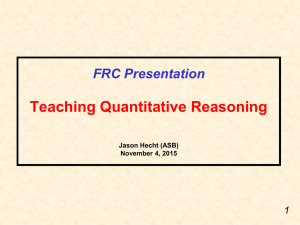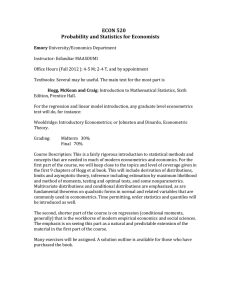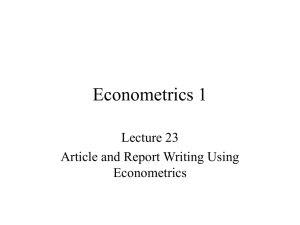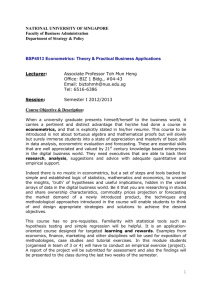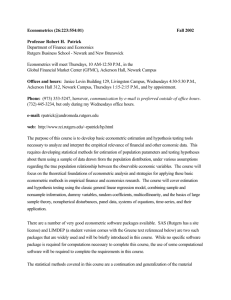Seminar in Empirical Microeconomics
advertisement
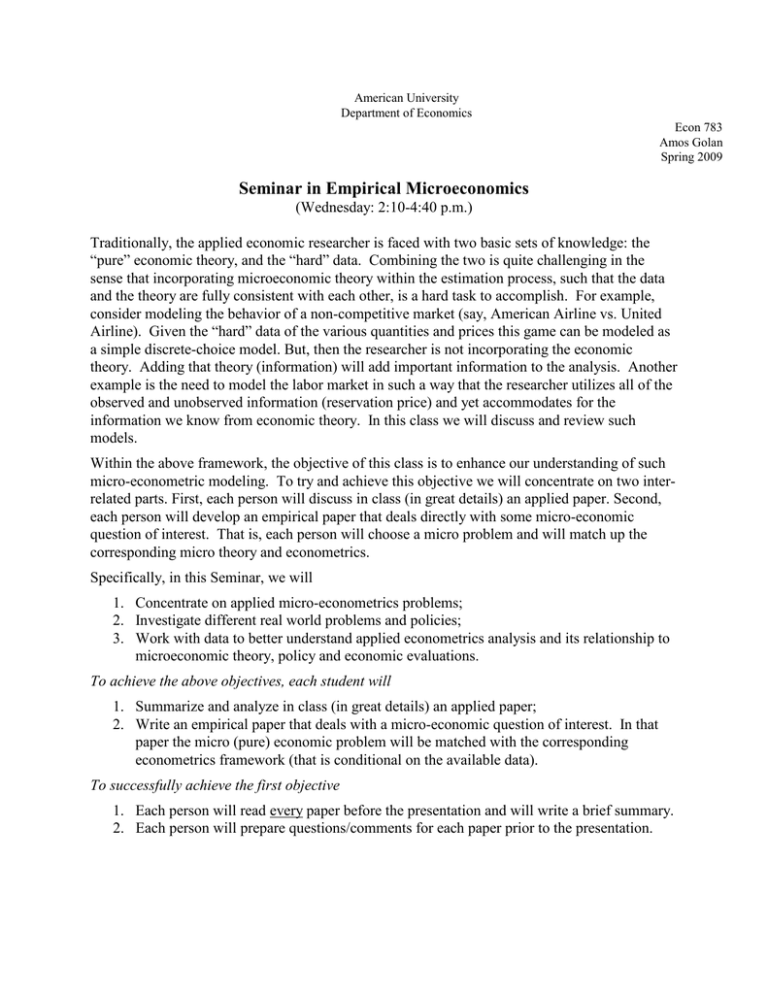
American University Department of Economics Econ 783 Amos Golan Spring 2009 Seminar in Empirical Microeconomics (Wednesday: 2:10-4:40 p.m.) Traditionally, the applied economic researcher is faced with two basic sets of knowledge: the “pure” economic theory, and the “hard” data. Combining the two is quite challenging in the sense that incorporating microeconomic theory within the estimation process, such that the data and the theory are fully consistent with each other, is a hard task to accomplish. For example, consider modeling the behavior of a non-competitive market (say, American Airline vs. United Airline). Given the “hard” data of the various quantities and prices this game can be modeled as a simple discrete-choice model. But, then the researcher is not incorporating the economic theory. Adding that theory (information) will add important information to the analysis. Another example is the need to model the labor market in such a way that the researcher utilizes all of the observed and unobserved information (reservation price) and yet accommodates for the information we know from economic theory. In this class we will discuss and review such models. Within the above framework, the objective of this class is to enhance our understanding of such micro-econometric modeling. To try and achieve this objective we will concentrate on two interrelated parts. First, each person will discuss in class (in great details) an applied paper. Second, each person will develop an empirical paper that deals directly with some micro-economic question of interest. That is, each person will choose a micro problem and will match up the corresponding micro theory and econometrics. Specifically, in this Seminar, we will 1. Concentrate on applied micro-econometrics problems; 2. Investigate different real world problems and policies; 3. Work with data to better understand applied econometrics analysis and its relationship to microeconomic theory, policy and economic evaluations. To achieve the above objectives, each student will 1. Summarize and analyze in class (in great details) an applied paper; 2. Write an empirical paper that deals with a micro-economic question of interest. In that paper the micro (pure) economic problem will be matched with the corresponding econometrics framework (that is conditional on the available data). To successfully achieve the first objective 1. Each person will read every paper before the presentation and will write a brief summary. 2. Each person will prepare questions/comments for each paper prior to the presentation. 2 3. The person presenting should (i) review and summarize the article, (ii) discuss the basic objectives, (iii) describe the theoretical model, (iv) describe the data, (v) discuss –in great details – the econometrics background and estimation approach (If Background material need, it should be presented). Note: extra Credit: Replication of the paper’s results using the same (or similar) data set. Note: All presentations are in power point. 4. Everybody attends all the classes. To successfully achieve the second objective 1. Each student will write an empirical paper on a micro problem that is interesting to her/him (note: to gain the most out of this class, it is essential to work and carry on the research within the time frame specified.) Where would you find a paper to summarize in class? 1. In the partial list below or search Econ Lit, library and the Web. 2. In one of the applied economic journals such as RESTAT, AER, JPE (search ://www.jstor.org/) or J. of Applied Econometrics (http://jae.wiley.com/jae/). The structure of the class is as follows: 1. First meeting is an organizational meeting, some discussions of what we will do and assignments of papers for each student. NOTE: By the beginning of the second meeting each person has to select a paper to be presented (after approval). It is your responsibility to search before the second meeting. 2. Second and third meeting: “Information Processing in Economics/Econometrics” (may include a brief review of information and entropy methods in econometrics) to be presented by Golan. 3. From fourth meeting, students’ presentations follow by class discussion and a further background/discussion when appropriate. 4. We will have one/two computer labs. Important Dates: 1. February 4 – Computer Lab (tentative). 2. February 18. Proposal for the Research paper is due. This includes: title, summary of project, relevant references and data description and sources. 3. March 11. No class (Spring Break). 4. April 8 – Computer Lab (tentative). 5. April 20 (Monday) – twelve noon. Papers are due. (No late submissions!) 6. April 22 (Wed.), 2-5 pm. Students present their papers (we start at 2:00 pm sharp). Mandatory. • Note: There will be one/two meetings in my office to discuss each person’s paper. 3 Grades: 1. Presentation in Class: 25%. 2. Participation in Class: 15%. 3. Final paper (and presentation in class): 60%. Office Hours (Roper 219): Tuesday 12:15-2:00 and by appointment. Tel: 885-3784; Email: @american.edu Useful Text Books and Background Material 1. Cameron and Trivedi, (CT) "Microeconometrics" (Cambridge, 2005) – Highly Recommended. 2. Greene, W. H., "Econometric Analysis" (New York, Macmillan, 6th ed., 2008). 3. Jeffrey M. Perloff, Larry S. Karp, Amos Golan, “Estimating Market Power and Strategies,” (Cambridge University Press, 2007). 4. Handbook of Econometrics Volumes 6A-6B; Eds. J. Heckman and E. Leamer (Elsevier, 2007). Search: ://www.bestbookbuys.com/ for best prices. Additional useful references 1. Amemiya, T., Advanced Econometrics (Harvard, 1985). 2. Ullah, A. and D. Giles, eds., Handbook of Applied Economic Statistics, Marcel Dekker, 1998. 3. Chow, Gregory C., Econometrics (New York: McGraw-Hill, 1983). 5. Mittelhammer, R. C., G. Judge and D. Miller, (MJM) Econometric Foundations (Cambridge, 2000). 4. Maddala, G. S., Limited Dependent and Qualitative Variables in Econometrics (Cambridge, 1983) Topics of Interest (Stars reflect highly recommended papers) All applied micro papers are relevant. Examples include applied games, labor economics such as wage equations, demand and/or supply estimation of a firm or an industry, expenditure and cost equations, survey analysis (such as qualitative choice type analysis), semi parametric models and inequality measures. These examples are not exhaustive. Below is a partial list of papers dealing with these issues covering different types of estimation methods. You can choose one of these, or any other paper of interest. All papers must be approved. General – Data Issues: 1. Greene 1.1-1.4; MJM 1.1-1.6 and 2.1-2.5. 2. Griliches, Z. Economic Data Issues in Handbook of econometrics / edited by Zvi Griliches and Michael D. Intriligator (North-Holland Pub. Co. ; New York, N.Y. 1983-1986). Download at: http://www.elsevier.com/hes/books/02/03/025/c0203025.htm 3. Heckman, and Smith. "Assessing the Case for Social Experiments," Journal of Economic Perspectives, Spring, 1995. Discrete Choice Models 1. Greene, 23; MJM, 20.1-20.3; Maddala, 1-3. 4 Tobit and other Censored and Truncated Regression Models 1. Greene, 24.1-24.4; MJM, 20.4. 2. Hausman, J. and D. Wise, Social experimentation, truncated distributions, and efficient estimation, Econometrica, 1977, vol 45, pp. 919-938. Sample Selection Models 3. Greene, 24.5; MJM, 20.4. 4. *Angrist, J., E. Bettinger, and M. Kremer, “Long-Term Educational Consequences of Secondary School Vouchers: Evidence from Administrative Records in Colombia,” AER 96(3) June 2006 : 847-862 5. Vella, Francis, Estimating models with sample selection bias: A survey, J. of Human Resources, Winter 1998, only pp. 127-144. 6. Newely, Powell, Walker, Semiparametric estimation of selection models: some empirical results, AER, May 1990. Limited Dependant Variables 1. *Chay, K. Y. and J. L. Powell, “Semiparametric Censored Regression Models,” Journal of Economic Perspectives. 15 (2001) 4 (Fall): 29-42 Treatment effects and Program Evaluations 1. See for example Imbens’s Web page: http://www.economics.harvard.edu/faculty/imbens) Panel Data GMM and Information-Theoretic Models 1. Greene, 9, 15; MJM, 12, 13, 16. 2. Balgati, B. H., Panel data methods, in Handbook of Applied Economic Statistic, (eds. Ullah and Giles), Marcel Dekker, Inc., 1998. 3. G. W. Imbens, R. H. Spady and P. Johnson, Information Theoretic Approaches to Inference in Moment Conditions Models, Econometrica, 66 (1998) 333-357. 4. Kitamura, Y. and M. Stutzer (1997), “An information-theoretic alternative to generalized method of moment estimation,” Econometrica, 66(4), 861-874. 5. A. Golan, “Information and Entropy Econometrics — A Review and Synthesis", Foundations and Trends® in Econometrics: Vol. 2: No 1–2, pp 1-145. 6. Hall, A., “Generalized Method of Moments” (Oxford University Press, 2005). Quantile Regression 1. *Koenker R. and K. F. Hallock, “Quantile Regression,” Journal of Economic Perspectives— Volume 15, Number 4—Fall 2001—Pages 143–156 Disontinuity 1. CT 25 2. *Lee, D., E. Moretti and M. J. Butler “Do Voters Affect Or Elect Policies? Evidence From The U. S. House,” QJE, August 2004, Vol. 119, No. 3, Pages 807-859 5 Instrumental Variables – Weeak Instruments 1. CT, 4 2. *Moreira, M. and L. Cruz, “On the Validity of Econometric Techniques with Weak Instruments Inference on Returns to Education Using Compulsory School Attendance Laws, THE JOURNAL OF HUMAN RESOURCES, 2005, 40(2) 393-410 The incidental parameter problem 1. CT, 23.2 2. *Tony Lancaster The incidental parameter problem since 1948, Journal of Econometrics 95 (2000) 391}413 Model/Variable Selection 1. Greene, 7; MJM, 18. Other Examples/Topics (Belong to any of the above or other topics) 1. 2. 3. Goux, D and E. Maurin, The Decline in Demand for unskilled labor: an empirical analysis method and its application, RESTAT, 2000, vol. 4, 596-607. Hellerstein, J. K. and G. W. Imbens, Imposing Moment Restrictions from Auxiliary Data by Weighting, RESTAT (1999) 81, 1-14. Mroz, T., The sensitivity of an empirical model of married women’s’ hours of work to econometric and statistic assumptions, Econometrica, 1987, 765-799. For Other Possible Topics of Possible Interest see for example Handbook of Applied Economic Statistics and Handbook of Econometrics 6A-6B
